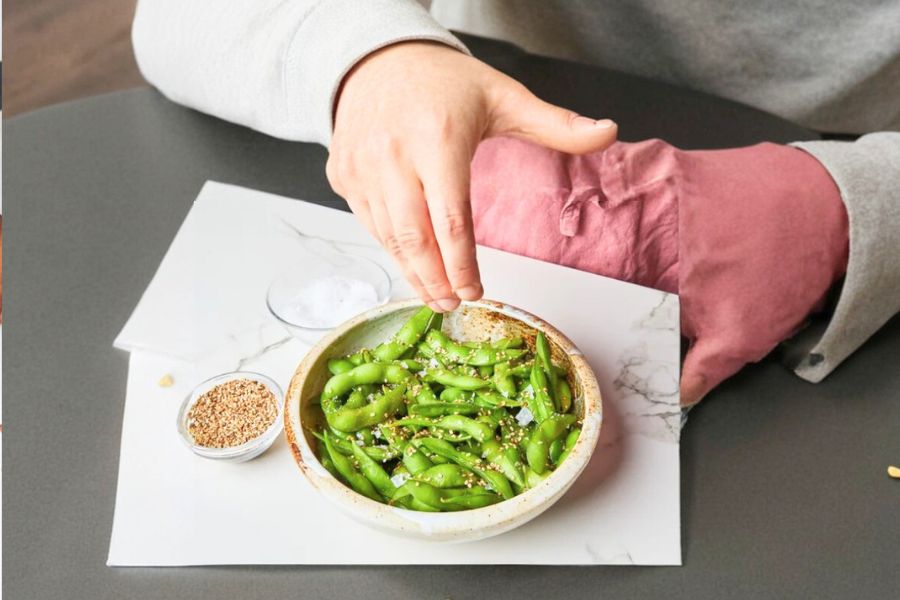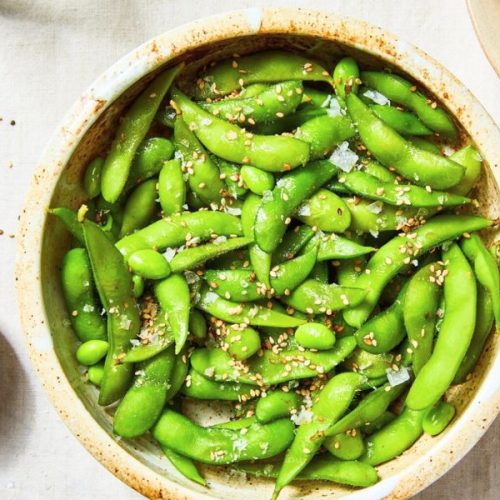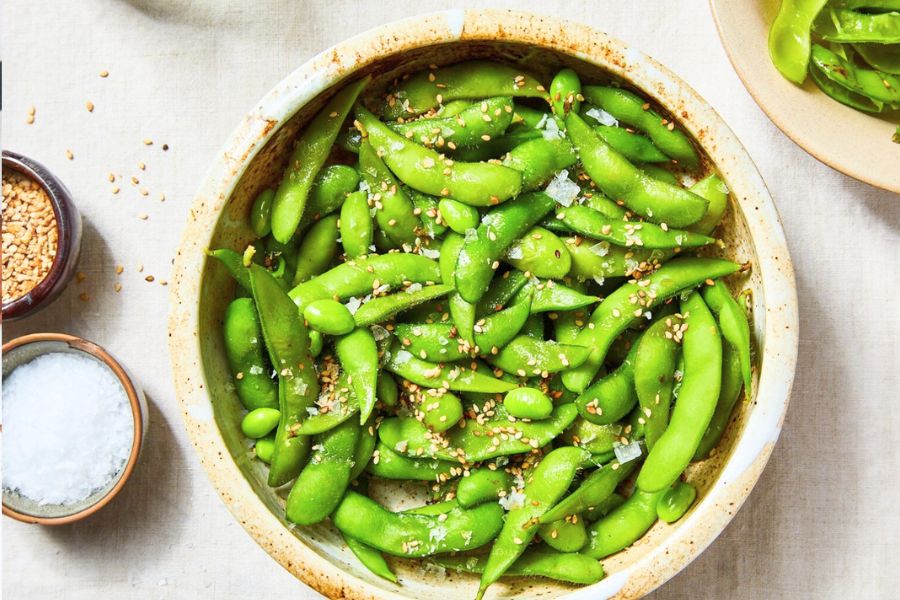This Edamame with sesame and sea salt recipe is a simple yet delicious way to enjoy a nutrient-dense snack or side dish.
What makes it special is its quick preparation and minimal ingredients, showcasing the natural flavor of edamame enhanced by toasted sesame seeds, a drizzle of fragrant sesame oil, and flaky sea salt
High in plant-based protein (22g per serving) and fiber, edamame supports muscle health and digestive wellness while being low in carbs, making it ideal for balanced eating.

The inclusion of healthy fats from sesame oil adds a satisfying richness without excess saturated fat, perfect for heart-conscious diets.
Its ease and speed—ready in under 20 minutes with zero baking—make it a fantastic everyday option, whether as a wholesome snack, appetizer, or part of a meal prep plan.
The recipe’s plant-based, gluten-free, and vegan-friendly qualities further boost its appeal for diverse dietary needs.
Must-Have Tools for Perfect Results
Large Pot:
Essential for boiling the edamame evenly and maintaining a controlled simmer. This versatile pot is indispensable for soups, pastas, and large-batch cooking.
Cooking Spoon
Perfect for stirring and gently moving the beans while cooking. A sturdy spoon also doubles for mixing and serving tasks in any kitchen.
Colander
Crucial for draining hot water quickly and rinsing edamame with cold water to stop cooking. This tool makes washing vegetables and draining pasta hassle-free.
Measuring Scale
Ensures precise ingredient quantities, especially for salt and edamame, to get consistent flavor and nutritional balance. A digital scale is a must-have for any precise home cook.
Toaster or Dry Skillet (optional for sesame seeds)
Toasting sesame seeds enhances their nutty aroma. A good-quality skillet or toaster oven helps elevate the flavor of many recipes beyond edamame.

20-Minute Edamame with Sea Salt
Equipment
- 1 arge pot
- 1 Cooking spoon
- 1 Colander
- 1 Measuring scale (optional but recommended)
- 1 Toaster or skillet (optional for toasting sesame seeds)
Ingredients
- 400 g frozen edamame pods
- 2 liters water
- 60 g coarse salt for boiling
- Sesame oil for drizzling
- Toasted sesame seeds for garnish
- Flaky sea salt for finishing
Instructions
- Prepare the Boiling Water: Begin by filling a large pot with 2 liters of fresh, cold water. Place the pot on the stove over high heat and bring the water to a rolling boil. Once boiling, carefully add 60 grams of coarse salt to the water. Stir the water gently with a cooking spoon to fully dissolve the salt. This salted water will help season the edamame pods evenly during cooking, enhancing their natural flavor.
- Add the Frozen Edamame: Without thawing, add the 400 grams of frozen edamame pods directly into the boiling, salted water.Be careful to avoid splashing as you drop the pods in. Using the cooking spoon, gently stir the edamame to make sure they’re fully submerged and separated. Lower the heat slightly to maintain a gentle simmer rather than a full boil, which prevents the beans from becoming mushy.
- Simmer Until Tender: Allow the edamame to simmer gently for 5 to 6 minutes. During this time, the pods will cook through and become tender but still maintain a pleasant bite. If your frozen edamame is partially cooked or pre-steamed (check packaging), adjust the simmering time to be shorter to avoid overcooking. You can test for doneness by removing one pod, allowing it to cool slightly, then squeezing the beans out. The beans should be tender yet firm.
- Drain and Cool the Edamame: Once cooked, immediately drain the edamame pods using a colander placed in the sink. To halt the cooking process and preserve the bright green color and firm texture, rinse the edamame under cold running water for about 30 seconds. This refreshing rinse stops the heat from continuing to cook the beans and helps them cool down for serving.
- Season and Serve: Transfer the cooled edamame to a serving bowl. Drizzle a light amount of fragrant sesame oil over the beans — the nutty oil enhances the natural flavor with rich, savory notes. Sprinkle toasted sesame seeds generously on top for crunch and aroma. Finish by scattering flaky sea salt evenly over the pods; the crystals add bursts of salty texture that contrast beautifully with the tender beans.
- Enjoy and Store: Serve the edamame immediately, either warm or chilled, depending on your preference. This dish makes a satisfying snack, appetizer, or side for any meal. If you have leftovers, store them in an airtight container in the refrigerator for up to two days. You can enjoy them cold or reheat briefly before serving.
Notes
- When boiling the edamame, use plenty of water and salt it well to season the beans evenly.
- If your edamame is pre-cooked, reduce boiling time accordingly to avoid overcooking.
- Rinsing the cooked edamame with cold water immediately stops the cooking process, keeping the beans firm and vibrant.
- For an extra layer of flavor, gently toast sesame seeds in a dry pan before sprinkling over the dish.
- Serve the edamame warm or chilled — both ways are delicious and make for a versatile snack or appetizer.
- This recipe is naturally vegan, gluten-free, and low in carbohydrates, making it suitable for many dietary preference
Chef’s Secrets for Perfect Edamame
To elevate this simple dish, start by ensuring your boiling water is well-salted — much like pasta water — to infuse the beans with flavor from the inside out.
Maintaining a gentle simmer instead of a vigorous boil prevents the edamame from becoming mushy and losing their bright green color.
Rinsing the beans immediately in cold water after cooking is key to preserving their texture and vibrancy.
For a deeper flavor profile, lightly toast the sesame seeds yourself; freshly toasted seeds release a nuttier aroma that pre-packaged seeds often lack.
Finally, be generous but balanced with sesame oil and flaky sea salt — these add richness and crunch without overpowering the natural, fresh taste of edamame.
Serving Suggestions for Every Occasion
This edamame dish is incredibly versatile and works wonderfully as a quick snack, an appetizer at dinner parties, or a side to complement Asian-inspired meals.
Serve it alongside sushi, grilled meats, or vegetable stir-fries for a complete meal.
For a fun twist, add a squeeze of fresh lime or a pinch of chili flakes for a subtle zing.
You can also toss the cooked edamame into salads or grain bowls to boost protein content and add texture.
Whether warm or cold, this dish’s mild yet satisfying flavor makes it an easy crowd-pleaser at any gathering.
Storage Tips to Keep Freshness
Cooked edamame stores well in the refrigerator for up to two days. To maintain freshness, transfer the beans to an airtight container once cooled.
Avoid adding sesame oil or salt before storing, as these ingredients can affect texture and flavor over time.
When ready to eat, enjoy them cold straight from the fridge or gently warm them in a pan or microwave, adding your toppings just before serving.
For longer storage, you can freeze cooked edamame in a freezer-safe bag, but be aware that texture might soften slightly upon thawing.
Frequently Asked Questions Answered Clearly
Q1: Can I use fresh edamame instead of frozen?
Absolutely! Fresh edamame can be cooked the same way but may require a slightly longer boiling time. Make sure to remove any tough stems before cooking.
Q2: Is this recipe suitable for low-sodium diets?
You can reduce the salt in the boiling water or skip the flaky sea salt topping to lower sodium content. The beans themselves provide plenty of flavor.
Q3: How do I know when the edamame is perfectly cooked?
Tender but firm to the bite is the ideal texture. If the beans mash easily, they’re overcooked. Test one pod by squeezing a bean out to check.
Q4: Can I make this recipe ahead of time?
Yes! You can cook the edamame in advance and refrigerate. Add the sesame oil and salt just before serving to keep the beans fresh and flavorful.
Q5: What are some good alternatives to sesame oil?
For a different flavor, try drizzling olive oil or chili oil. Each adds its own unique taste and can tailor the dish to your preference.
This recipe has been adapted and simplified from the original version by kitchenstories. We’ve refined the steps for a smoother cooking experience and added helpful notes, nutrition insights, and essential kitchen tools to make it even easier for home cooks.

